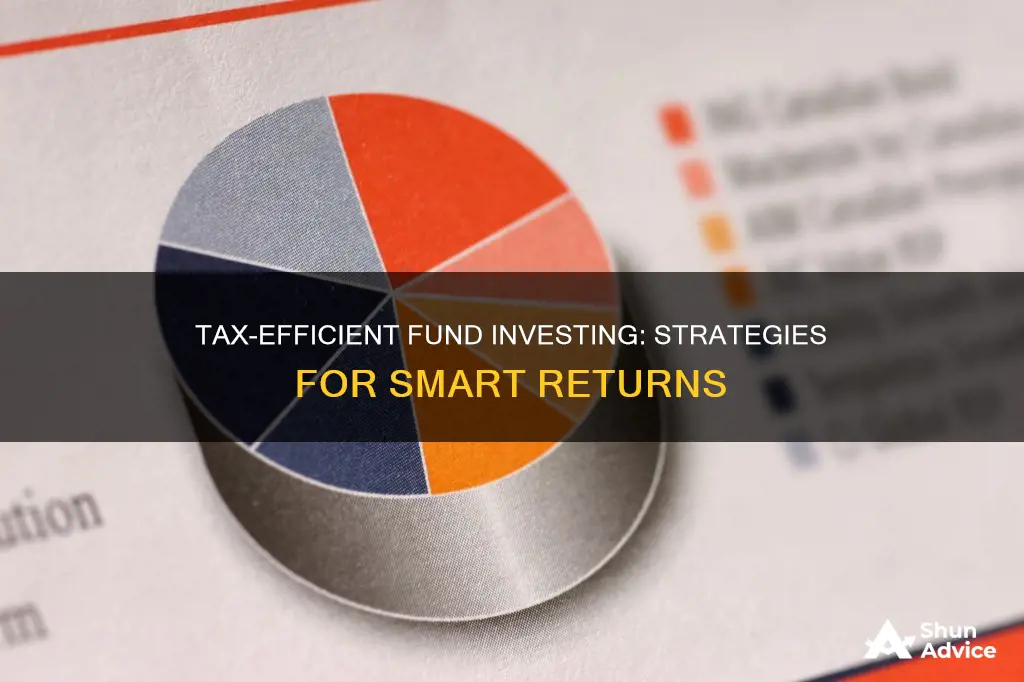
Investing is a great way to grow your money, but it's important to remember that taxes can take a big bite out of your returns. That's where tax-efficient investing comes in—it's a strategy that can help you maximize your returns by minimizing the taxes you pay. Whether you're saving for retirement or generating cash, tax-efficient investing is a useful approach to consider.
There are two main types of investment accounts: taxable and tax-advantaged. Taxable accounts, such as brokerage accounts, offer more flexibility but provide fewer restrictions. On the other hand, tax-advantaged accounts like IRAs and 401(k)s have annual contribution limits and come with tax benefits.
To invest in tax-efficient funds effectively, you should understand the tax implications of different investments and choose the right accounts to hold them. This may involve selecting tax-managed funds, exchange-traded funds (ETFs), or municipal bonds, which are typically more tax-efficient. Additionally, consider the timing of your buy and sell decisions, taking advantage of realized losses, and employing specific strategies such as charitable giving.
Remember, while taxes are an important consideration, your investment decisions should be primarily driven by your financial goals, risk tolerance, and timeline. Consulting a qualified financial advisor or tax specialist can help you navigate the complexities of tax-efficient investing and ensure you make the best choices for your situation.
| Characteristics | Values |
|---|---|
| Types of Tax-Efficient Accounts | Tax-deferred accounts (traditional IRAs and 401(k) plans); Tax-exempt accounts (Roth IRAs and Roth 401(k)s); Health Savings Accounts (HSAs); 529 plans; Irrevocable trusts |
| Taxable vs. Tax-Advantaged Accounts | Taxable accounts offer more flexibility but returns are taxed based on how long the asset was held; Tax-advantaged accounts have annual contribution limits but provide tax breaks |
| Taxable Accounts and Investments | Individual stocks; Tax-managed funds; Exchange-traded funds (ETFs); Municipal bonds; Treasury bonds; Real estate; Life insurance; Annuities |
| Tax-Advantaged Accounts and Investments | Mutual funds; Index funds; Individual stocks; Municipal bonds; Master Limited Partnerships (MLPs) |
| Tax Loss Harvesting | Writing off realized investment losses against gains to reduce taxable income |
| Tax-Efficient Strategies | Buy-and-hold investing; Donating appreciated securities to charity; Using a 1031 exchange for real estate; Taking advantage of lower long-term capital gains rates |
What You'll Learn

Understand the difference between capital gains and dividends or cash income
Understanding the difference between capital gains and dividends or cash income is essential for tax-efficient investing. Here's a detailed overview:
Capital Gains:
Capital gains refer to the profit made when an investment is sold for a higher price than the original purchase price. In other words, it is the difference between the purchase price and the selling price. For example, if you buy a stock for $1,000 and later sell it for $1,200, your capital gain is $200. Capital gains can occur in various investments, such as stocks, real estate, or other capital assets. It's important to note that an investor only realizes a capital gain when the investment is sold, and a capital loss occurs when the investment is sold at a lower price than the purchase price.
The tax implications of capital gains depend on whether they are classified as short-term or long-term holdings. Short-term capital gains are for assets held for less than a year and are usually taxed as ordinary income. On the other hand, long-term capital gains are for assets held for more than a year and are typically taxed at lower rates, such as 0%, 15%, or 20% in the US, depending on the investor's tax bracket.
Dividends:
Dividends, on the other hand, are payouts made by corporations to their stockholders from the company's profits. They are often considered a "reward" or "bonus" for shareholders who have invested in the company's equity. Dividends can be paid out periodically, such as monthly or annually, and they can be in the form of cash, property, or stock. Dividends are treated as income for that tax year and are taxed accordingly.
Dividends can be classified as ordinary or qualified. Ordinary dividends are taxable as income, while qualified dividends are taxed at the lower capital gains rate. In the US, most stock dividends qualify to be taxed as capital gains. It's worth noting that dividends do not impact a company's income or expenses; instead, they are distributed from the shareholders' equity.
Cash Income:
Cash income refers to the income received in the form of cash, which can include various sources such as salary, wages, interest, or dividends. When it comes to investing, cash income specifically refers to dividends paid out in cash. The tax treatment of cash income depends on the type of dividend it is associated with. Ordinary dividends, which are taxable as income, are considered cash income. Meanwhile, qualified dividends, which are taxed at the capital gains rate, may also be received as cash income.
In summary, the key difference between capital gains and dividends or cash income lies in their nature and tax treatment. Capital gains are profits realized from the sale of investments, while dividends are payouts from a company's profits to its shareholders, and cash income specifically refers to dividends paid out in cash. The tax implications vary, with capital gains taxed based on the holding period and dividends taxed as ordinary income or capital gains, depending on their qualification. Understanding these differences is crucial for making informed investment decisions and optimizing tax efficiency.
Retirement Planning: Safely Investing for Peace of Mind
You may want to see also

Practice buy-and-hold investing
Taxes can be one of the biggest expenses on investments. So, it is important to practice tax-efficient investing to minimize your tax burden and maximize your bottom line. One of the simplest and most effective strategies to achieve this is to practice buy-and-hold investing.
The Internal Revenue Service (IRS) taxes your investment income in two ways: capital gains and dividends or cash income. Capital gains taxes apply when you sell an investment for cash, while dividends or cash income is money received during the year that is usually taxed for that tax year.
By practicing buy-and-hold investing, you can legally avoid capital gains taxes by holding your investments indefinitely and only paying taxes when you sell. This strategy also tends to result in better investment performance as passive investing often outperforms active investing over longer periods. This means you will likely make more money and pay less to the IRS.
Additionally, by holding investments for the long term, you can take advantage of lower long-term capital gains tax rates. These rates are typically lower than short-term capital gains tax rates, which are taxed at the ordinary income rate. For example, in 2023, individual filers who earned less than $44,625 in ordinary taxable income could avoid taxes on capital gains and qualified dividends entirely, up to a certain threshold.
Buy-and-hold investing is a powerful strategy for minimizing taxes and maximizing returns. It is a simple approach that can be a key component of a comprehensive tax-efficient investing strategy.
Bernie Madoff's Ponzi Scheme: Avoiding Client Fund Investments
You may want to see also

Choose between a traditional IRA and a Roth IRA
When choosing between a traditional IRA and a Roth IRA, it's important to consider your current financial situation, anticipated tax bracket in retirement, age, retirement timeline, tax-filing status, income, and retirement goals. Here are some key differences between the two:
Traditional IRA
- Tax-deferred growth: Contributions are made with pre-tax dollars, providing an upfront tax break. Taxes are paid when funds are withdrawn in retirement.
- Tax-deductible contributions: Contributions may be tax-deductible, depending on income levels and tax filing status.
- Required minimum distributions (RMDs): You are generally required to start withdrawing a minimum amount of money at age 73.
- Early withdrawals: Withdrawing funds before age 59 1/2 may result in paying taxes on contributions and earnings, as well as a 10% early withdrawal penalty.
- Eligibility: Anyone with earned income can contribute. However, tax deductibility is phased out at higher income levels if the contributor or their spouse has access to a workplace retirement plan.
Roth IRA
- Tax-free growth and withdrawals: Contributions are made with after-tax dollars, allowing tax-free growth and withdrawals in retirement.
- No upfront tax breaks: Contributions are not tax-deductible.
- No RMDs: There are no required minimum distributions during the owner's lifetime.
- Early withdrawals: Withdrawing contributions can be done at any time, for any reason, without taxes or penalties. However, withdrawing earnings before age 59 1/2 may result in taxes and a 10% penalty, unless an exception applies.
- Income limits: There are income caps beyond which individuals cannot contribute at all. For 2024, single filers must make less than $146,000, and married couples filing jointly must make less than $230,000.
In summary, traditional IRAs offer immediate tax benefits and are suitable for those seeking a tax break in the current tax year. On the other hand, Roth IRAs provide tax-free growth and withdrawals, making them attractive for those who expect to be in a higher tax bracket during retirement.
Renaissance Medallion Fund: An Exclusive Investment Guide
You may want to see also

Take advantage of tax-loss harvesting
Tax-loss harvesting is a strategy that can help you reduce your tax bill. It involves selling an investment at a loss to offset the taxes resulting from a capital gain. Here are some tips to take advantage of tax-loss harvesting:
- Understand the basics: Tax-loss harvesting means selling investments that have lost value, realising the loss, and then using that loss to offset taxable capital gains or income. This strategy can help lower your tax bill.
- Timing is important: Tax-loss harvesting must be done before the end of the calendar year, on December 31. It cannot be done after this date.
- Know the eligibility: Tax-loss harvesting applies only to investments held in taxable accounts. It does not apply to tax-sheltered accounts such as 401(k)s, 403(b)s, IRAs, or 529s.
- Consider your tax bracket: Tax-loss harvesting is most beneficial for those in higher tax brackets. If you are in a lower tax bracket, you may want to postpone tax-loss harvesting until you reach a higher bracket to maximise savings.
- Be mindful of wash sales: Do not buy the same or a substantially identical investment within 30 days before or after selling an investment at a loss. This is known as a wash sale and will result in the loss being disallowed.
- Put proceeds to good use: If you sell an investment at a loss, use the proceeds to rebalance your portfolio, invest in a promising company, or buy into an ETF or mutual fund that gives you exposure to a new sector or asset class.
- Consult professionals: Tax-loss harvesting is a complex strategy. Consult financial advisors or tax professionals to determine if and how it applies to your specific situation.
A Beginner's Guide to BSE Index Fund Investing
You may want to see also

Consider asset location
Asset location is an important consideration when investing in tax-efficient funds. The basic idea is to hold different types of assets in different types of accounts to minimize taxes. Here are some key points to consider:
- Taxable vs. tax-advantaged accounts: Taxable accounts, such as brokerage accounts, offer more flexibility but provide fewer tax benefits. On the other hand, tax-advantaged accounts, such as IRAs and 401(k)s, have tax advantages but come with restrictions and annual contribution limits.
- Dividend stocks: Consider holding dividend stocks in tax-advantaged accounts, such as IRAs, to avoid taxes on distributions.
- Capital gains: Stocks with probable capital gains can be held in a regular taxable account to take advantage of tax deferral until the investment is sold.
- Tax-efficient investments: Municipal bonds, for example, are typically exempt from federal taxes and may receive preferential state tax treatment. Holding these in a taxable account can reduce your tax liability.
- Tax-loss harvesting: You can use tax-loss harvesting to offset taxable capital gains with realized investment losses, reducing your overall tax bill.
- Retirement accounts: Traditional IRAs and 401(k)s offer tax-deferred growth, while Roth IRAs and Roth 401(k)s offer tax-free growth and withdrawals but do not provide an immediate tax deduction.
- Health savings accounts (HSAs): HSAs offer triple tax advantages—tax-deductible contributions, tax-deferred growth, and tax-free withdrawals for qualified medical expenses.
- Irrevocable trusts: Setting up an irrevocable trust can shield you from estate tax and gift tax consequences by removing assets from your personal estate.
- Taxable vs. tax-advantaged investments: Active mutual funds, for example, can generate taxable capital gains, while passive funds like index funds and exchange-traded funds (ETFs) tend to be more tax-efficient due to lower turnover.
Mutual Fund SIPs: Where to Invest for Maximum Returns
You may want to see also
Frequently asked questions
There are two main types of investment accounts: Taxable and Tax-Advantaged. Taxable accounts, such as brokerage accounts, offer more flexibility and fewer restrictions. Tax-advantaged accounts like IRAs and 401(k)s provide tax benefits but have annual contribution limits and penalties for early withdrawals.
The IRS taxes investment income differently from wages. Capital gains, or profits from selling assets like stocks or property, are usually taxed only when realized (i.e., the asset is sold). Dividends or cash income, on the other hand, are typically taxed for the year they are received.
There are several strategies to reduce taxes on investment gains, including buy-and-hold investing, contributing to tax-advantaged accounts like IRAs and 401(k)s, tax-loss harvesting, and considering asset location (holding certain investments in tax-advantaged vs. taxable accounts).
Some investments are more tax-efficient than others. Passive investments, such as index funds and exchange-traded funds (ETFs), tend to be more tax-efficient due to lower turnover, resulting in fewer capital gains distributions. Municipal bonds are also tax-efficient as they are typically exempt from federal taxes and may have preferential state tax treatment.
While tax considerations are important, they should not be the primary driver of your investment strategy. Investment decisions should be based on your financial goals, risk tolerance, and timeline. Incorporate tax-efficient strategies into your portfolio management process to potentially improve your after-tax returns.







